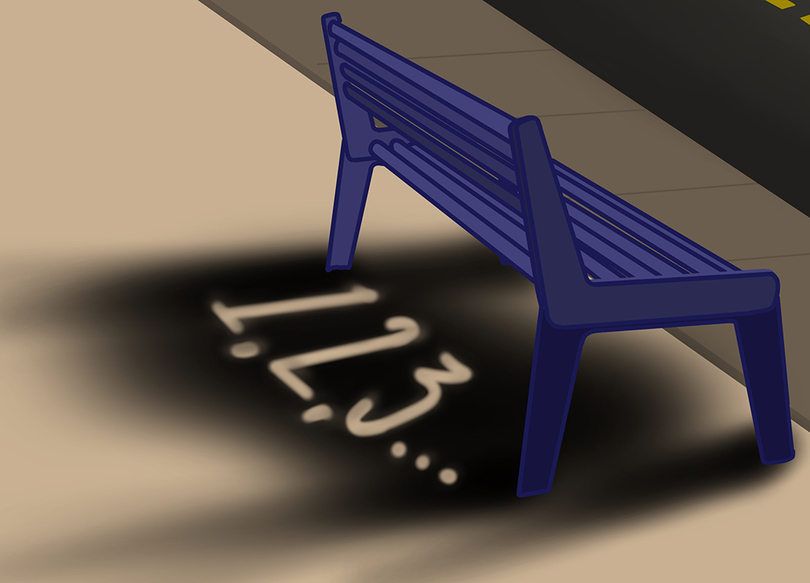More than 500 people sought shelter in Onondaga and neighboring counties during annual Point-in-Time Count

Every year at the end of January, people across the nation participate in a one-night count of all sheltered and unsheltered homeless individuals and families. This year, the count was on January 24. Sarah Allam | Head Illustrator
Bundled up in scarves, hats and gloves, 50 people at the Rescue Mission sipped from their steaming Dunkin’ Donuts and Cafe Kubal coffee cups. As the clock neared 8 p.m., the group waited for their instructions.
“Get sugared and caffeinated up,” said Melissa Marrone, the director of the Housing and Homeless Coalition of Central New York. “You’re going to need it.”
It was 19 degrees outside, and the crowd was about to head out into the city on foot and by car for the next four hours.
Every year at the end of January, a one-night count of all sheltered and unsheltered homeless individuals and families is conducted across the United States, known as the Point-in-Time Count. For Onondaga, Oswego and Cayuga counties, the count is conducted by the U.S. Housing and Urban Development’s Continuum of Care, which is the Housing and Homeless Coalition of Central New York.
The count includes homeless people in emergency housing, supportive housing and transitional housing, as well as all unsheltered persons.
This year’s count, conducted on the night of Jan. 24, found seven unsheltered individuals staying outside in Onondaga County. For all three counties, 52 families, 425 individuals and 19 unaccompanied youths under the age of 18 had sought shelter, said Sarah Schutt, an administrator at the Housing and Homeless Coalition of Central New York, in an email.
As the night went on and the temperature dropped, the shelters and the Rescue Mission had filled up. The Mission was 104 percent full as of 3 p.m. that day for men and 102 percent full for women, Schutt said.
When Marrone was first present for a count in 2015, she was one of only two volunteers. This year, more than 50 volunteers showed up to blanket neighborhoods, streets and 24-hour locations like gas stations and fast-food restaurants.
Karen Belge, a program director at the Salvation Army, was one.
“We talk to the person who is on the street and homeless and we try to get them to go inside, whether that’s here at the Rescue Mission or a women’s or family shelter,” she said about the procedures for getting homeless individuals to safety. “If that doesn’t work, we try to get phone numbers and try to connect them with programs that will help them not be homeless, any program that gets them off the street.”
The volunteers looked for telltale signs: footprints in the snow, makeshift tents and people on park benches or in alleyways. Last year, the count found four people in 24-hour locations, Marrone said.

Anna Henderson | Digital Design Editor
The next step is to familiarize front-desk and frontline employees at these locations with 211, the number they can dial if they see someone experiencing homelessness. Calling 211 will ensure this individual has shelter for the night.
The information collected from the Point-in-Time Count is supplemented by information in the Homeless Management Information System database, which contains records of all the homeless persons the coalition has documented in Syracuse since 2009. This data helps determine the kind of federal funding the coalition receives and how it uses the funding.
“It’s really important to get base demographic information, so we can add them to our database,” Marrone said. “We make funding decisions based off that information. If, for instance, we have more individuals than families, we apply for more individual funding and vice versa.”
But federal funding may not be sufficient or long-lasting enough to end homelessness, said John Tumino, founder of In My Father’s Kitchen.
Tumino used to be a restaurant chef, but now runs the nonprofit organization through which he offers direct assistance to the homeless. He does so by providing them restaurant-quality meals and connecting them with any necessary services.
“We’re making a push to end chronic homelessness, but it doesn’t help people who are still living in the shelters,” he said. “There’s always apartments being built all over the place, but these are high-end apartments. We need something that’s affordable.”
Tumino said he and his wife have assisted 85 people with housing in the last seven years. Chronic homelessness in Syracuse has slowly come down in numbers, he said. Now, the concern is youth homelessness and problems like drug addiction that are connected with this demographic.
Tyler Gilyard, an employee at the Syringe Exchange Program at ACR Health, is currently working with a recent grant that aids homeless persons in the 18-24 age group who identify as LGBTQ+.
“When somebody shows up at the shelter and identifies as LGBT, the shelter will call me. The Mission can be a predatory environment,” he said. “Being that they’re LGBT, they’re a little more vulnerable than the average person that comes. It’s a way to fast-track them out of there.”
The grant is used for assistance with housing and rent for up to two years. In the meantime, Gilyard works to get the recipients stable employment as he gradually weans them off support. The end goal, he said, is to get them to be self-sufficient.
The HHC gets nearly $9 million of HUD funding for permanent supportive housing and rapid rehousing funds, Marrone said. These are given as grants to various nonprofits like Catholic Charities or Salvation Army to help people who are coming immediately out of homelessness.
Both Tumino and Marrone said the collaboration between different agencies is a promising sign in the fight to end homelessness.
Said Marrone: “We ensure all the pieces of the puzzle come together to end homelessness.”




